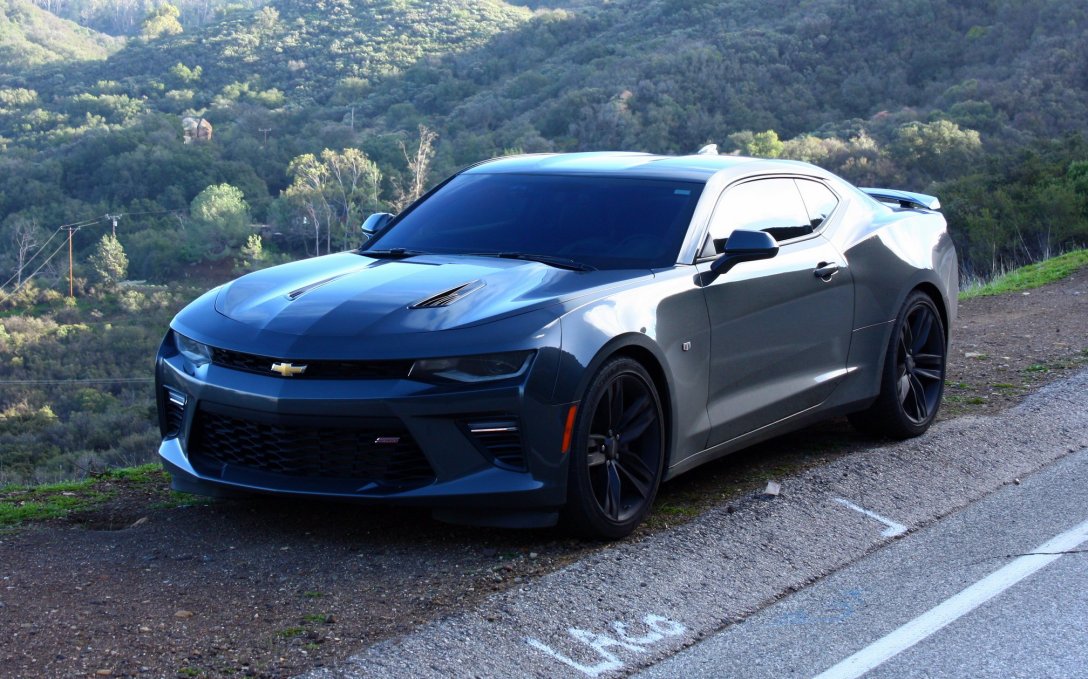I’ve never been a muscle car guy, preferring sports cars and exotics—cars that turn—to Mustangs and Camaros that seemed myopically focused on quarter-mile runs. It may have been the childhood trips to Sears Point (now Sonoma Raceway) to watch race cars hustle around the twelve historic turns that convinced me that a fast car turned left and right as well as accelerated hard. Or maybe it was the fact that the route to my grandma’s coastal ranch included 50 miles of mountain twisties, and on each trip, I’d watch my grandma slickly change gears, clip apexes and straighten the corners with double yellow transgressions as she navigated her home turf. Whatever it was, American cars never cornered in my youth, and so it was the Japanese and European cars that were the apple of my eye.
And now, thirty years later, I find myself falling in love with Mustangs and Camaros. I’ve changed, they’ve changed, we’ve met in the middle. Having put aside my prejudices and driven these historic American lines, I’ve found that the classic recipe of guttural V8 up front and fat drive wheels behind serves up massive helpings of loud and dirty fun. And Ford and Chevy have discovered their passion for building road-course-ready sports cars and given the Mustang and Camaro the moves to slice-and-dice at the racetrack.
So, it is with this newly unfolding understanding of my proclivities that I distractedly finish my workday ahead of a pre-planned rendezvous with friend Sage and his rental 2016 Camaro SS. This is the SS that is being heralded as the best sports car value from the USA, the Camaro that’s leap-frogged the Mustang and perhaps hopped past the BMW M3/M4. I’ve heard the hype, I’m excited by the hype, and yet I’m slightly skeptical. Can Chevy is going to make me a believer?
Then the phone rings: “Dude, this Camaro feels faster than the McLaren 570GT!” Sage tells my disbelieving ears. Three furious V8 crescendos immediately follow this proclamation: Sage must be trying to prove his point with a hard pull to fourth gear. As good as Verizon call quality is, the G-forces are not transmitting, but in their place, the laughter from the nut behind the wheel is making a more important point. The Camaro is a hilariously fun car.
Thirty minutes later, I roll up at our meeting point, a mountain summit with long views overlooking LA’s best beachfront real estate. The Camaro is parked to enjoy the view, though its striking exterior could be equally at home in the Batcave. (Or at least that is what its owner thinks, as a Batman logo has been stuck to the rear bumper just under the SS badge.) I have no problem admitting that this is a handsome car if one that I think is functionally compromised by concept car proportions that trim the roofline—and thus the window area—to accentuate a low-slung, speed-machine visage.
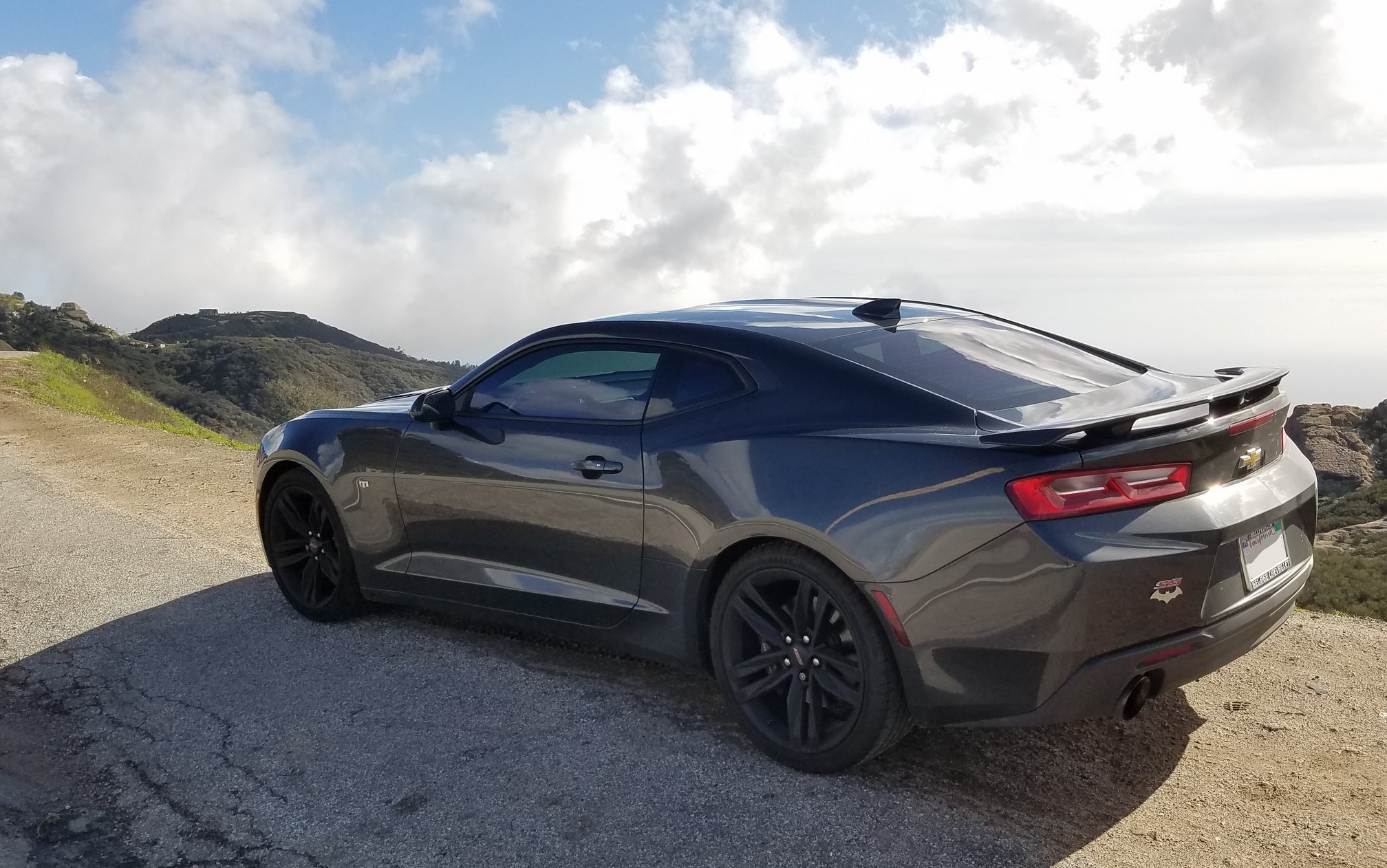
It’s not just the scenery that has drawn us to this location. A few years ago, we flogged a 2013 Ford Mustang GT on this mountain and found it to be a bit of a wild bucking bronco when equipped with its base (boulevard cruiser) suspension. We are both very curious to see how the Camaro does on fast and undulating Stunt Road. Actually, Sage already knows, as he drove Stunt to get up to the peak. However, he nearly totaled the Chevy on a landslide of suitcase-sized rocks, and he’s too nervous to hand me the keys just yet. He’ll drive first, so I don’t auger into the hazard in my first go behind the wheel.
From the passenger’s seat, the Camaro hides its speed as we rush back to sea level. Sage calls out the mph at the end of the first straightaway: It’s 20 mph faster than I would have guessed. The hand-me-down LT1 motor is as potent as it was in the Corvette Stingray, even if the Camaro burdens it with an additional 250lbs of metal to move. Stunt’s bumps—whether they are encountered mid-straight or mid-corner—are shrugged off by the Camaro, and the ride is surprisingly supple yet very well controlled. The car does not corner as flat as Kansas but instead shifts softly side-to-side and fore-to-aft with the steering, acceleration, and braking. The Mustang had this plushness without the control. The M Sport BMW 3 and 5-series have this control with a smidge firmer ride. The Camaro’s pitch and roll on this base (non-magnetic) suspension are exceptionally modest for the plushness of the ride.
Also plush are the 2SS Camaro’s front seats. Finished in supple leather, these ventilated thrones are so soft and comfortable that I’d love to put them in my living room: They’d make even a Lord of the Rings movie marathon bearable. They have torso bolstering, but they are not skinny-guy tight, so I am flopping about a bit as a passenger. (As a driver, I can preemptively brace for the changing forces and the seats are fine.)

The Tour de Stunt stops short at the rock slide. We play good Samaritans and roll the sandstone boulders to the road’s shoulder. My reward is that I get the SS’s keys and my first chance behind the wheel. Settling into the driver’s seat, and I find myself a little more claustrophobic on the left side of the car than I was on the right. Is it just that the double-hump gauge cluster trims away a few square inches of outward visibility? The forward visibility in the Camaro isn’t that bad… I sit deep and low that my line of sight is only interrupted by the A-pillars. (You might not find this exceptional, but in many sports cars, I have to duck to see past the rearview mirror.) The rear visibility is pretty horrendous, though.
I drive back up Stunt. The immediacy and magnitude of the V8’s torque are eye-opening; the difference in response and pull between this V8 and my Ford Focus RS‘s turbo-four (the car that took me up the mountain) could not be starker. The LT1 V8 has the greased-lightning reactivity I know from my E90 M3, but with twice the grunt. The C7 Corvette felt like one of the fastest cars I’d ever driven; the Camaro SS is noticeably slower. I don’t see how Sage likened this to the 570GT for pace…
I am let down slightly by GM’s fresh new 8-speed automatic. There is a (thankfully predictable) half-second delay on the upshifts, but the upshifts are only snappy if I use full throttle. But since the V8 is overmatched to the rear tire grip, I’m not using much full throttle. The downshifts are less consistent in their delivery and are slurred rather than rev-match blipped. At least, with so many gear ratios, there always appears to be one—or two!—right gears for a corner.
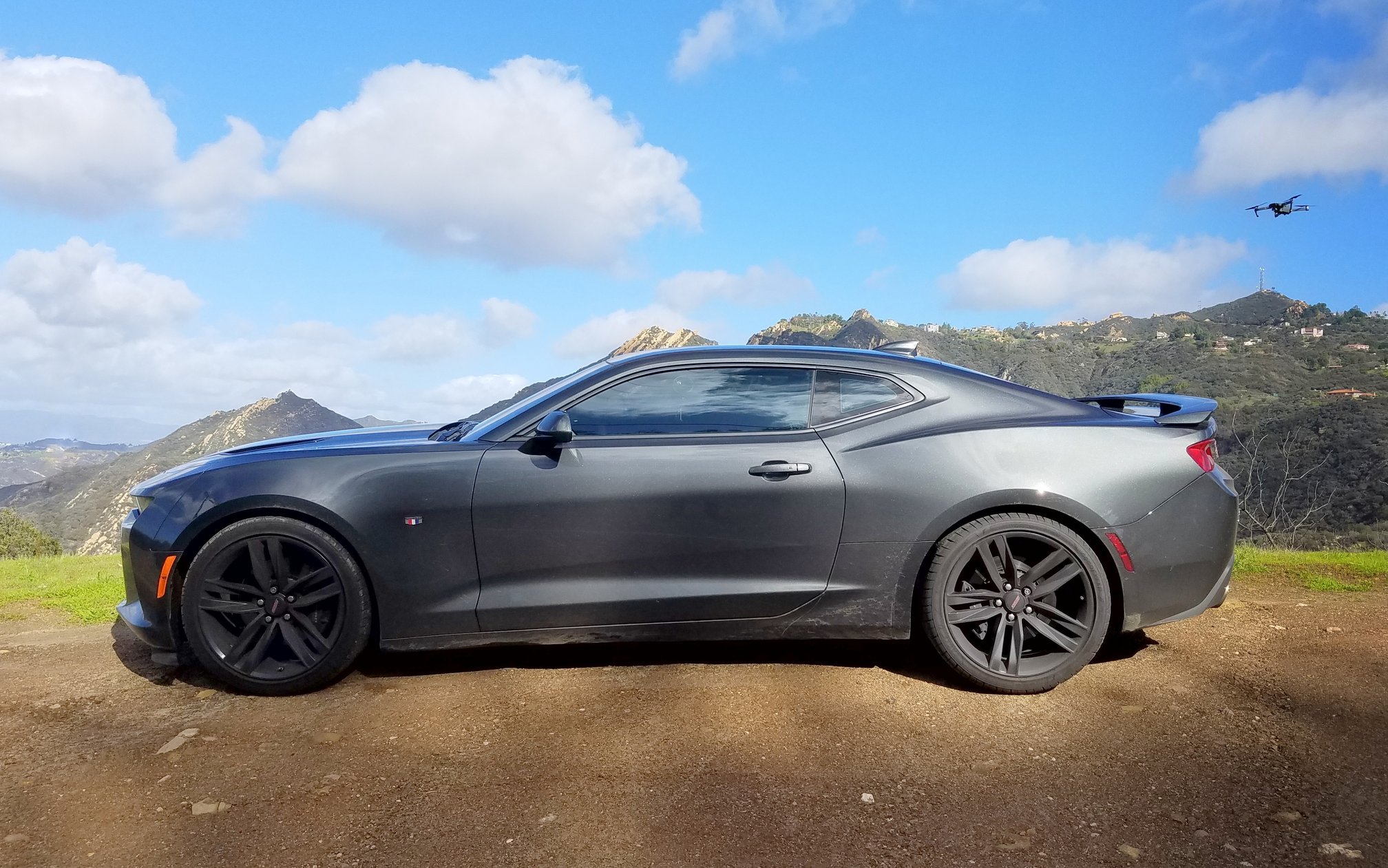
Where Piuma runs a spectacular mountain ridge, Sage powers up his drone and shoots video of the Camaro trundling up and down the hill. (The driving is slow, so the flying camera can keep pace.) Afterward, I park the SS in front of the best mountain scenery and capture still photos. The afternoon is glorious and sunny, a welcome respite from the winter rains that lashed the state. The storms do make for messy roads with water, mud and rocks hiding around nearly every corner.
The SS feels a little large—and too fast—on tight and twisting Piuma. We collect the Focus RS and head for open sweepers.
Driving alone in the Chevy, the marvel of this car starts sinking in. The Camaro handles broken roads with comfort and aplomb—and speed!—yet avoids being so capable that driving at sane speeds becomes boring. The excitement is kept alive by the keen controls, bellowing engine, and ever-scratching rear tires.
On Mulholland Hwy, I savor the long sweeping bends along the perimeter of Malibu Creek State Park. The power is explosive and comes in so hard that even quick part-throttle adjustments, like quickly adding 20% throttle mid-corner, can break traction. (Is Track mode’s throttle mapping over-amplified?) It’s a good thing that GM’s traction control is so finely tuned because the rear tires are quick to light up, and I’m leaning heavily on the electronic aids as I fly out of corners. (The Goodyear Eagle F1 tires, 245mm front and 275mm rear, are due for replacement, and one is even showing cords.) Whenever I get on the gas hard, the front end lifts slightly, and the steering lightens, then the rear end starts dancing as the driven tires exhaust their available grip. The car is clearly traction-limited rather than power-limited, and it makes adjusting the car’s course with throttle very easy. The chassis and stability control are so good, though, that throttle steering the Camaro is eminently entertaining rather than frighteningly intimidating. The last time I was this tempted to play with benign corner-exit oversteer was during my drive of the Subaru BRZ, and that car had a much harder time overwhelming its traction. The SS, or rather the LT1 V8, makes the game so much easier.
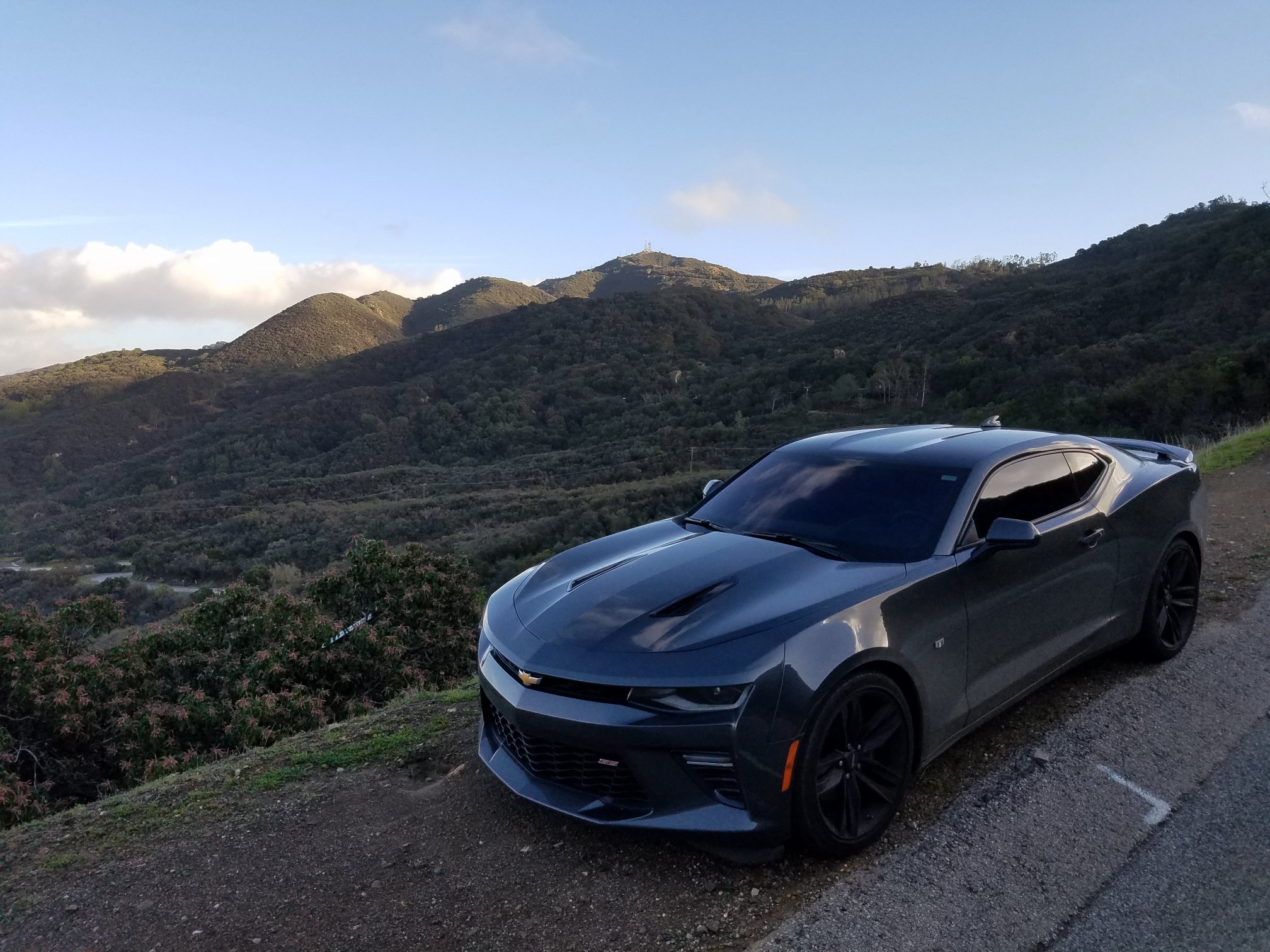
Mulholland’s sweepers are so much fun in the SS that we switch cars so that Sage can have a play. I hadn’t intended to directly compare my Focus RS to the Camaro, but now that I am back in my personal car, I can’t avoid noticing the differences. The RS’s torque band feels minuscule and anemic; its peak pull is only on tap between 4k and 5.5k rpm, whereas the SS shreds it from idle all the way to its 7k rpm redline. The Focus’s steering feels flighty and rubbery after the Chevy’s perfectly weighted and ratioed rack. In fact, even if the road feedback isn’t quite there, the weighting and accuracy of the Camaro’s steering would be at home in my BMW E90 M3. (A switch to Michelin Pilot Super Sport tires could improve the feedback.) The RS also manages to feel very tippy yet overly dampened versus the flat but compliant SS. A heave that literally launches the RS into the air is such a non-event in the SS that Sage can’t recall the bump when I try to describe it to him at our next roadside chat.
Of course, the biggest difference between the cars is their driving styles. In the RS, the strategy is to go full throttle pre-apex and let the trick AWD drive the car around the corner. You need real throttle control in the SS because wide-open throttle will leave you backward in a ditch if the traction control does not intervene first.

But, today is not about the Focus RS, so I park the Ford and become Robin (the passenger) in the Batmobile. Batman—err…Sage—drives the Snake, provoking unexpected understeer and oversteer on the recently rain-slickened surface. He then turns heads crossing Kanan by leaving elevens across the intersection. As we dodge storm debris on Mulholland Hwy West, we reminisce about the last fast car we drove here. It was a car that Chevy benchmarked when developing the Camaro: the BMW M4.
Motor Trend says so, but is the Camaro SS really a match for the M4? In a word, yes. By the power, acceleration and handling numbers, the SS is absolutely competitive with the M4. And the Chevy is more entertaining than the Bimmer because the SS has a bombastic attitude and has predictable manners that make it approachable to drive. A year ago, the M4 puzzled Sage and me on these same roads with inconsistent throttle response, infuriatingly aggressive traction control, and oddly rubbery steering. The Camaro has none of these sins. Chevy’s V8 sounds awesome (especially when compared to the M4’s I6), and the sound amplifies the excitement.
If I were to pick and pull the best aspects of these two cars, what would I take? The steering and engine (for its power, response, and soundtrack) would have to come from the Camaro. Traction control would be GM’s, too; BMW has not figured out how to make TC that stays out of the way of a competent driver. The gearbox, though, would come from the M4; the M-DCT creams GM’s automatic in both quickness and smoothness. Interior appointments—especially the steering wheel—would be BMW sourced; BMW has more luxurious appointments that are conservatively styled and less likely to look dated with time. For the ride, I’m not really sure which suspension and chassis I’d take: The Chevy has a plusher ride without sacrificing performance, but the M4’s chassis is better controlled and communicates more road texture. I guess I want a hybrid of the two, a solution that keeps the frolicky nature of the standard SS suspension but brings back some of that seat-of-the-pants road feel. (Does the Camaro’s optional 1LE suspension bridge this gap?)
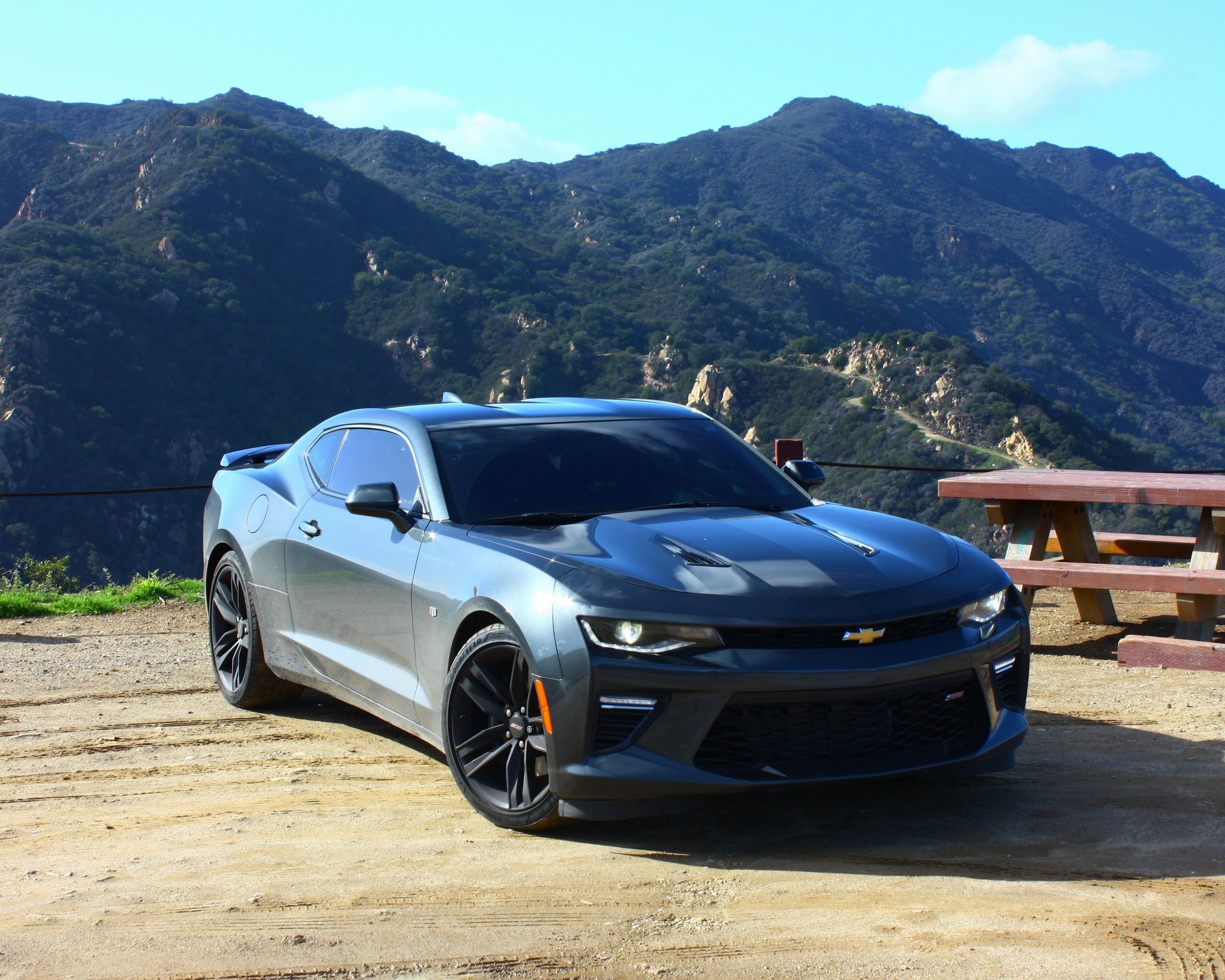
Our fantasy game is contrived, as Chevy and BMW are not about to collaborate on a joint-venture sports coupe. Forced to accept reality, Sage and I both acknowledge that the Camaro SS is the car we’d want to take home. The Camaro’s engine, steering, and predictable handling are more compelling than the M4’s transmission, luxury equipment, and firmer handling, especially when the M4 is $30k more expensive.
(While BMW and Chevy are not about to collaborate on a car, there is really no excuse for Cadillac not to stuff the LT1 engine in the ATS-V.)
And then there is my newfound appreciation for the fact that what is fast on the racetrack is not necessarily fun on the road. The Mustang and Camaro are already hilarious in the mountains. Would stickier tires and a more hunkered-down suspension actually increase the fun? I doubt it. Feeling the SS lift its nose and slither its tail with every throttle application has been the highlight of my day.
The air is full of sunshine and ocean spray at the bottom of Mulholland, but somehow my thoughts are a little darker, brooding, critical. As I switch back into the driver’s seat, I feel like something is missing in the Camaro. The cars I really love have some point of design or engineering that dazzles and enraptures me. Something that every time I get in the car, I set my eyes on, or tune my ears too, or cosset with my hands and say, “Wow, they really knocked it out of the park!” The Camaro’s exterior design—while handsome—is not that thing; I’ve poo-pooed the Camaro for prioritizing thuggish posture over outward visibility. The interior isn’t “it” either; the quality isn’t bad, but I’m over alien-spaceship-inspired cabins, and all the strikes and slashes don’t look like they’ll stand the test of time. Tech and luxury aren’t the Camaro’s fortes either. So what’s left? Mechanical engineering: chassis and drivetrain.
I’m struggling to accept it, but it’s the small-block Chevy V8 that makes the Camaro better than good, dazzling. The problem is that Chevy V8s are so ubiquitous that I’ve become a bit deaf to their song. If I’m out and about and I hear a Chevy V8, I’m not going to break my neck trying to spot the vehicle because, more often than not, a clapped-out Silverado is driving by rather than a sexy Corvette or Camaro. But if I try really hard and look beyond my prejudices, I see it is the LT1 motor that is the star of the show: It imbues the SS with its furious, punchy and muscular character.

With the rapidly sinking sun at my back, I blast back into the mountains, laughing giddily as the Camaro playfully slays Malibu’s serpentine roads. Considering that the Camaro SS outdoes the M4 yet starts at the same price as my Focus RS, it personally hurts that this car is as fun as it is. If my life did not require four doors, this Chevy would be in my garage.
